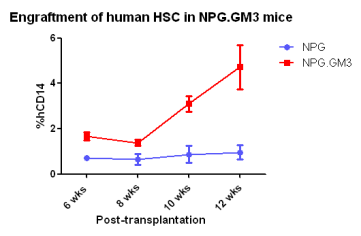General Information
Strain Name | HuHSC-NPG-GM3 |
Origin | Beijing Vitalstar Biotechnology Co., Ltd. |
Background | NPG |
Coat Color | Albino |
Development
The transgenic double-positive mice obtained by crossing NPG-CSF2 with NPG-IL3 mice were mated and bred, and the double-positive mice were screened and retained in the progeny littermates, ultimately resulting in two transgenic, pure mouse strains named NPG-GM3 mice. After transplantation of human hematopoietic stem cells (HSCs), the HuHSC-NPG-GM3 mice can support human myeloid cell and dendritic cell differentiation and development better than ordinary NPG mice, and also promote human T cell differentiation, presenting a more human immune system.
Phenotype
1. Engraftment of human CD34+ HSCs in NPG-GM3 mice to reconstitute human immune system








Fig1. Engraftment of human CD34+ HSCs in NPG-GM3 mice successfully reconstituted human T and B cells, NK and myeloid cells.
The reconstitution level of human immune cells in peripheral blood was analyzed by flow cytometry. Compared to NPG, NPG-GM3 had higher reconstitution levels of hCD3+ T cells, hCD56+ NK cells, hCD33+ myeloid cells, hCD14+ monocytes, and hCD11b+ myeloid cells.
HuHSC-NPG-GM3 Mouse Application Examples
1. Engraftment of human CD34+ HSCs in B-NDG mice to reconstitute human immune system and construct a human colon cancer model to evaluate the immunomodulatory effects of recombinant TRAIL

Fig2. Immune microenvironment study of recombinant TRAIL regulation by HSC-NPG-GM3 transplantation of HCT116.
1×106 log-phase HCT116 cells were subcutaneously inoculated on the right side of female Hu-HSC-NPG mice. When the tumors grew to 100-150 mm3, the mice were treated with PBS, shTRAIL (2 mg/kg), trabectedin (0.15 mg/kg per mouse), and a combination of shTRAIL and trabectedin. The results showed that compared to the PBS group, all three treatment groups (shTRAIL, trabectedin, and their combination) significantly inhibited tumor growth. Immune cell experiments found that trabectedin upregulated CD45+ immune cells and M1 macrophages within the tumor, reduced the number of immunosuppressive cells, including Tregs and IL-10+ M2-like macrophages. The combined treatment not only significantly increased the number of activated CD8+ T cells but also significantly inhibited the proliferation of Treg cells and IL-10+ M2 macrophages.
HuHSC-GM3-NPG Mice Applications
1. Research on tumor immunity and tumor microenvironment
2. Establishment of human CMV virus infection model, etc.
3. Safety evaluation of CAR-T drugs
4. Infectious disease research, such as exploring the role of myeloid cells in HIV pathogenesis
5. Inflammatory disease research such as allergy and asthma
Reference
1. Wang X, et al. Dose-related immunomodulatory effects of recombinant TRAIL in the tumor immune microenvironment. J Exp Clin Cancer Res. 2023, 42(1):216.
2. Ito R, et al. A humanized mouse model to study asthmatic airway inflammation via the human IL-33/IL-13 axis. JCI Insight. 2018, 3(21):e121580.

 animalmodel@vital-bj.com
animalmodel@vital-bj.com +8610-84928167
+8610-84928167